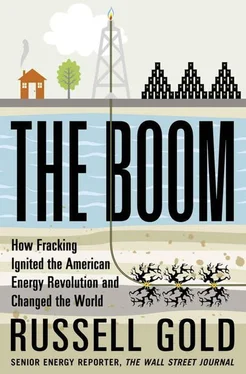So far, the shallow aquifer that supplies drinking water on my parents’ property and neighboring farms hasn’t turned briny. Tests for contaminants have been negative. The well itself descended 7,200 feet. If it was built correctly, it is doubtful that man-made fractures created any new pathways for existing pollutants, or chemicals used to create the well, to rise up into the aquifer. It isn’t impossible, but independent studies in neighboring counties called such an occurrence “unlikely” and haven’t turned up any evidence of this taking place.
If the fracking didn’t create any pollution pathways, perhaps the well itself did. The layers of cement and steel pipe inserted into the wellbore and designed to protect shallow drinking water aquifers don’t always work. My father asked for information about what tests Chesapeake ran on the well to determine if the cement held, but he gave up asking after getting the runaround for a couple weeks. Even if the well was good on day one, what will happen to the Matt 2H after a decade, or decades, of the pipes and cement sitting in a hot environment with corrosive liquids? Was Chesapeake in a rush to finish the well and move on to the next? I don’t know. State inspectors cited the company for failing to follow “best management practices” to protect a nearby stream. What the inspectors saw on the surface led to violations, but what about what was below and out of sight?
There’s another question about the well—and many others like it. When Chesapeake completed the Matt 2H, flushing out the water it injected underground, how much natural gas was allowed to vent into the atmosphere? How much escaped from the pipelines that delivered it around the country? Methane, the main ingredient of natural gas, is a potent greenhouse gas. Releasing it adds to the carbonization of the atmosphere and contributes to climate change. Indeed, if too much natural gas leaks out, the benefits of making electricity from gas versus coal can disappear. I have no way of knowing how much methane escaped from the Matt 2H. When future wells are drilled on the pad on the Farm, federal rules that go into effect in 2014 will require “green completions” to capture this methane. Some companies already use this equipment and report that not only is most of the methane captured, this approach often pays for itself by avoiding the expense of buying the diesel otherwise needed to fuel drill-site machinery.
In July 2011, a month before fracking of the Matt 2H began, the lead author of a large study on natural gas told the US Senate Committee on Energy and Natural Resources that there are benefits and risks associated with fracking. The risks, said Ernest Moniz, then a professor at the Massachusetts Institute of Technology, are “challenging but manageable. In all instances, the risks can be mitigated to acceptable levels through appropriate regulation and oversight.” As he said in a speech a year later, “All of these are manageable, which should not be confused with managing them.” Three months after he made these comments, Moniz was nominated to become secretary of energy. Both the federal government and state governments are taking steps to identify problems and devise fixes. The environmental impact is improving. But more can be done and, as long as regulators and the industry don’t shy away from problems, can continue to be done.
Thanks to fracking, the United States is producing more natural gas than ever. The same technology used to get gas out of shale is now being used to get oil as well. In the summer of 2013, the United States pumped nearly 7.5 million barrels a day of crude oil, a level unseen since 1990. North Dakota, home to the Bakken Shale, was producing 875,000 barrels a day, up from 150,000 barrels five years earlier. For decades, the United States has imported millions of barrels of oil every day. Imports are now falling. While it seems unlikely that America will ever become “energy independent,” it is certainly unwinding its dependence on foreign suppliers in the Middle East and Africa. For generations, the United States has used its military might to keep oil flowing, fighting wars and patrolling sea lanes. Maybe this era will now come to an end. By 2020, America could become the largest global oil producer.
This is a stark change from the past, when so much energy production was outsourced. US energy consumers were able to use vast amounts of oil and gas without having to confront the impact or legacy of their addiction. A few years ago, I flew over Nigeria’s coastal mangrove swamps in a helicopter. The vegetation on the sides of the Niger River was blanched white and denuded of leaves. It felt like I was looking at a black-and-white film. After decades of oil development, and the extraction of more than $1 trillion worth of oil, Nigeria struggles with rampant corruption and internal conflict. It remains a poor nation by any measure. The Niger Delta was the source of nearly 8 percent of the oil imported by the United States from 1981 to 2011. In the first half of 2013 it was 4 percent and falling.
Fracking means that the United States is producing more and more of the energy it consumes in its backyard. That didn’t work out too well for Ottis Grimes. But there is no question that the localized environmental impact is significantly less than in 1919 Burkburnett, or modern-day Nigeria.
Drilling wells in a more environmentally responsible manner isn’t enough for some fossil-fuel critics. They argue that burning coal, oil, and gas is releasing too much carbon and accelerating the unpredictable consequences of climate change. But not all fuel is equal in this measure. To achieve the same amount of energy, burning coal generates 42 percent more carbon dioxide than crude oil, which itself generates 18 percent more than natural gas. Critics argue that slowing the rate at which carbon is building up in the atmosphere, by burning gas instead of coal, is a half measure, and the Earth is too far into climate change for this kind of incremental progress. What is needed, they contend, is a wholesale switch to fuels that don’t emit any carbon.
Sometimes I wonder what the energy landscape would look like if the industry couldn’t frack shale rocks; if all that oil and gas were still locked away out of reach. Would there be more wind and solar power? Would we be putting liquefied corncobs and prairie grass into our fuel tanks? Would we have found ways to be more fuel efficient, investing in public transportation and insulated windowpanes?
I suspect that America would be importing huge amounts of natural gas from overseas along with the fleet of tankers that brings crude oil. Fracking has not derailed the growth of renewable energy. Electricity from renewables, power sources that emit no carbon, has grown fast. The wind provided three-tenths of 1 percent of US power a decade ago. It is now about 4 percent. Considering that American energy consumption is Brobdingnagian, that’s historic growth. Solar is also growing but remains much smaller.
Energy systems change when something better and cheaper comes along. New England’s whalers stopped harpooning when refined petroleum proved a better light source. Crude oil replaced coal in trains and boats in the first couple decades of the twentieth century because it was a more compact, capable fuel. Natural gas is making inroads because fracking allows it to be abundant and cheap, at least in the United States. Some believed that the twenty-first century belonged to renewables—and it might yet—but fracking has breathed new life into fossil fuels.
Fracking is a challenge to renewable energy systems such as wind farms and solar arrays. The glut of inexpensive gas has made it hard for renewable energy to compete on the nation’s power grids. But this competition is also forcing wind and solar to get better and, arguably, helping accelerate the maturation of these technologies. The abundance of inexpensive natural gas helped cushion the sticker shock of higher-priced renewables. Wind and sun are power sources that turn on and off. The wind doesn’t always blow, and clouds can block the sun. For the power grid to function as we expect, there needs to be something to back up this intermittent renewable energy. Coal and nuclear power plants aren’t well suited for the job. They don’t like to be turned on and off quickly. But natural gas power plants are more nimble and can hold together a mélange of renewable and fossil fuels. This possible future is on view in Texas, which leads the nation in wind power and natural gas production. One study, paid for by renewable energy advocates, concluded the path to low-carbon power generation will require both gas and renewables working together.
Читать дальше












